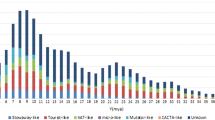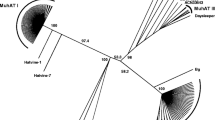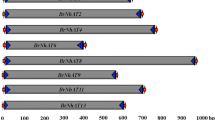Abstract
Miniature inverted-repeat transposable elements (MITEs) are truncated derivatives of autonomous DNA transposons, and are dispersed abundantly in most eukaryotic genomes. We aimed to characterize various MITEs families in Brassica in terms of their presence, sequence characteristics and evolutionary activity. Dot plot analyses involving comparison of homoeologous bacterial artificial chromosome (BAC) sequences allowed identification of 15 novel families of mobile MITEs. Of which, 5 were Stowaway-like with TA Target Site Duplications (TSDs), 4 Tourist-like with TAA/TTA TSDs, 5 Mutator-like with 9–10 bp TSDs and 1 novel MITE (BoXMITE1) flanked by 3 bp TSDs. Our data suggested that there are about 30,000 MITE-related sequences in Brassica rapa and B. oleracea genomes. In situ hybridization showed one abundant family was dispersed in the A-genome, while another was located near 45S rDNA sites. PCR analysis using primers flanking sequences of MITE elements detected MITE insertion polymorphisms between and within the three Brassica (AA, BB, CC) genomes, with many insertions being specific to single genomes and others showing evidence of more recent evolutionary insertions. Our BAC sequence comparison strategy enables identification of evolutionarily active MITEs with no prior knowledge of MITE sequences. The details of MITE families reported in Brassica enable their identification, characterization and annotation. Insertion polymorphisms of MITEs and their transposition activity indicated important mechanism of genome evolution and diversification. MITE families derived from known Mariner, Harbinger and Mutator DNA transposons were discovered, as well as some novel structures. The identification of Brassica MITEs will have broad applications in Brassica genomics, breeding, hybridization and phylogeny through their use as DNA markers.






Similar content being viewed by others
References
Altschul SF, Madden TL, Schaffer AA, Zhang J, Zhang Z, Miller W, Lipman DJ (1997) Gapped BLAST and PSI-BLAST: a new generation of protein database search programs. Nucleic Acids Res 25:3389–3402
Altschul SF, Gertz EM, Agarwala R, Schaffer AA, Yu YK (2009) PSI-BLAST pseudocounts and the minimum description length principle. Nucleic Acids Res 37:815–824. doi:10.1093/nar/gkn981
Benjak A, Boue S, Forneck A, Casacuberta JM (2009) Recent amplification and impact of MITEs on the genome of grapevine (Vitis vinifera L.). Genome Biol Evol 1:75–84. doi:10.1093/gbe/evp009
Bergemann M, Lespinet O, M’Barek SB, Daboussi MJ, Dufresne M (2008) Genome-wide analysis of the Fusarium oxysporum mimp family of MITEs and mobilization of both native and de novo created mimps. J Mol Evol 67(6):631–642. doi:10.1007/s00239-008-9164-7
Brandes A, Heslop-Harrison JS, Kamm A, Kubis T, Doudrick T, Schmidt T (1997) Comparative analysis of the chromosomal and genomic organization of Ty1-copia-like retrotransposons in pteridophytes, gymnosperms and angiosperms. Plant Mol Biol 33:11–21
Bureau TE, Wessler SR (1992) Tourist: a large family of small inverted repeat elements frequently associated with maize genes. Plant Cell 4:1283–1294. doi:10.1105/tpc.4.10.1283
Bureau TE, Wessler SR (1994) Stowaway: a new family of inverted repeat elements associated with the genes of both monocotyledonous and dicotyledonous plants. Plant Cell 6:907–916. doi:10.1105/tpc.6.6.907
Capy P (2005) Classification and nomenclature of retrotransposable elements. Cytogenet Genome Res 110:457–461. doi:10.1159/000084978
Chen J, Hu Q, Zhang Y, Lu C, Kuang H (2013) P-MITE: a database for plant miniature inverted-repeat transposable elements. Nucleic Acid Res: 1–6. doi:10.1093/nar/gkt1000
Cifuentes M, Eber F, Lucas MO, Lode M, Chevre AM, Jenczewski E (2010) Repeated polyploidy drove different levels of crossover suppression between homoeologous chromosomes in Brassica napus allohaploids. Plant Cell 22(7):2265–2276. doi:10.1105/tpc.109.072991
Eagle S, Crease, T (2012) Copy number variation of ribosomal DNA and Pokey transposons in natural populations of Daphnia. Mobile DNA 3(1). URL http://dx.doi.org/10.1186/1759-8753-3-4
Doyle JJ, Doyle JL (1990) Isolation of plant DNA from fresh tissue. Focus 12:13–15
Feschotte C, Mouches C (2000) Evidence that a family of miniature inverted-repeat transposable elements (MITEs) from the Arabidopsis thaliana genome has arisen from a pogo-like DNA transposon. Mol Biol Evol 17:730–737
Flavell AJ, Knox MR, Pearce SR, Ellis TH (1998) Retrotransposon-based insertion polymorphisms (RBIP) for high throughput marker analysis. Plant J 16:643–650
Ge XH, Wang J, Li ZY (2009) Different genome-specific chromosome stabilities in synthetic Brassica allohexaploids revealed by wide crosses with Orychophragmus. Ann Botany 104:19–31. doi:10.1093/aob/mcp099
Goubely C, Arnaud P, Tatout C, Heslop-Harrison JS, Deragon JM (1999) S1 SINE retroposons are methylated at symmetrical and non-symmetrical positions in Brassica napus: identification of a preferred target site for asymmetrical methylation. Plant Mol Biol 39:243–255
Heneen WK, Geleta M, Brismar K, Xiong Z, Pires JC, Hasterok R, Stoute AJ, Scott RJ, King GJ, Kurup S (2012) Seed colour loci, homoeology and linkage groups of the C genome chromosomes revealed in Brassica rapa–B. oleracea monosomic alien addition lines. Ann Botany 109(7):1227–1242. doi:10.1093/aob/mcs052
Hikosaka A, Nishimura K, Hikosaka-Katayama T, Kawahara A (2011) Recent transposition activity of Xenopus T2 family miniature inverted-repeat transposable elements. Mol Genet Genomics 285(3):219–224. doi:10.1007/s00438-010-0599-3
Jiang N, Bao Z, Zhang X, Eddy SR, Wessler SR (2004a) Pack-MULE transposable elements mediate gene evolution in plants. Nature 431:569–573. doi:10.1038/nature02953
Jiang N, Feschotte C, Zhang X, Wessler SR (2004b) Using rice to understand the origin and amplification of miniature inverted repeat transposable elements (MITEs). Curr Opin Plant Biol 7:115–119. doi:10.1016/j.pbi.2004.01.004
Junier T, Pagni M (2000) Dotlet: diagonal plots in a web browser. Bioinformatics 16:178–179
Jurka J, Kapitonov VV, Pavlicek A, Klonowski P, Kohany O, Walichiewicz J (2005) Repbase update, a database of eukaryotic repetitive elements. Cytogenet Genome Res 110:462–467. doi:10.1159/000084979
Kuang H, Padmanabhan C, Li F, Kamei A, Bhaskar PB, Ouyang S, Jiang J, Buell CR, Baker B (2009) Identification of miniature inverted-repeat transposable elements (MITEs) and biogenesis of their siRNAs in the Solanaceae: new functional implications for MITEs. Genome Res 19:42–56. doi:10.1101/gr.078196.108
Kubis SE, Heslop-Harrison JS, Desel C, Schmidt T (1998) The genomic organization of non-LTR retrotransposons (LINEs) from three Beta species and five other angiosperms. Plant Mol Biol 36: 821–831. http://aob.oxfordjournals.org/content/82/suppl_1/45.abstract
Kuhn GC, Heslop-Harrison JS (2011) Characterization and genomic organization of PERI, a repetitive DNA in the Drosophila buzzatii cluster related to DINE-1 transposable elements and highly abundant in the sex chromosomes. Cytogenet Genome Res 132(1–2):79–88. doi:10.1159/000320921
Kuipers AG, Heslop-Harrison JS, Jacobsen E (1998) Characterisation and physical localisation of Ty1-copia-like retrotransposons in four Alstroemeria species. Genome 41(3):357–367
Kumar S, Atri C, Sangha MK, Banga S (2011) Screening of wild crucifers for resistance to mustard aphid, Lipaphis erysimi (kaltenbach) and attempt at introgression of resistance gene(s) from Brassica fruticulosa to Brassica juncea. Euphytica 179(3):461–470
Lu C, Chen J, Zhang Y, Hu Q, Su W, Kuang H (2012) Miniature inverted-repeat transposable elements (MITEs) have been accumulated through amplification bursts and play important roles in gene expression and species diversity in Oryza sativa. Mol Biol Evol 29:1005–1017. doi:10.1093/molbev/msr282
Lyons M, Cardle L, Rostoks N, Waugh R, Flavell AJ (2008) Isolation, analysis and marker utility of novel miniature inverted repeat transposable elements from the barley genome. Mol Genet Genomics 280:275–285. doi:10.1007/s00438-008-0363-0
Madlung A, Comai L (2004). The effect of stress on genome regulation and structure. Ann Botany 94 (4): 481–495. URL http://dx.doi.org/10.1093/aob/mch172
Menzel G, Krebs C, Diez M, Holtgräwe D, Weisshaar B, Minoche AE, Dohm JC, Himmelbauer H, Schmidt T (2012) Survey of sugar beet (Beta vulgaris L.) hAT transposons and MITE-like hATpin derivatives. Plant Mol Biol 78:393–405. doi:10.1007/s11103-011-9872-z
Menzel G, Heitkam T, Seibt KM, Nouroz F, Müller-Stoerme M, HeslopHarrison JS, Schmidt T (2014) The diversification and activity of hAT transposon in Musa genome. Chr Res 22(4):559–571
Oki N, Yano K, Okumoto Y, Tsukiyama T, Teraishi M, Tanisaka T (2008) A genome-wide view of miniature inverted-repeat transposable elements (MITEs) in rice, Oryza sativa ssp. japonica. Gen Genetic Sys 83:321–329
Ouyang S, Buell CR (2004) The TIGR Plant Repeat Databases: a collective resource for the identification of repetitive sequences in plants. Nucleic Acids Res 32:D360–D363. doi:10.1093/nar/gkh099
Sarilar V, Marmagne A, Brabant P, Joets J, Alix K (2011) BraSto, a Stowaway MITE from Brassica: recently active copies preferentially accumulate in the gene space. Plant Mol Biol 77:59–75. doi:10.1007/s11103-011-9794-9
Shirasawa K, Hirakawa H, Tabata S, Hasegawa M, Kiyoshima H, Suzuki S, Sasamoto S, Watanabe A, Fujishiro T, Isobe S (2012) Characterization of active miniature inverted-repeat transposable elements in peanut genome. Theor Appl Genet 124(8):1429–1438. doi:10.1007/s00122-012-1798-6
Sikka SM (1940) Cytogenetics of Brassica hybrids and species. J Genetics 40:441–509
Sonnhammer EL, Durbin R (1995) A dot-matrix program with dynamic threshold control suited for genomic DNA and protein sequence analysis. Gene 167: GC1-10
Sun G, Pourkheirandish M, Komatsuda T (2009) Molecular evolution and phylogeny of the RPB2 gene in the genus Hordeum. Ann Botany 103 (6): 975–983. URL http://dx.doi.org/10.1093/aob/mcp020
Tu Z (2001) Eight novel families of miniature inverted repeat transposable elements in the African malaria mosquito, Anopheles gambiae. Proc Natl Acad Sci USA 98:1699–1704. doi:10.1073/pnas.041593198
Tu Y, Sun J, Ge X, Li Z (2009) Chromosome elimination, addition and introgression in intertribal partial hybrids between Brassica rapa and Isatis indigotica. Ann Botany 103 (7): 1039–1048. URL http://dx.doi.org/10.1093/aob/mcp045
Walley PG, Teakle GR, Moore JD, Allender CJ, Pink DAC, Buchanan-Wollaston V, Barker G (2012) Developing genetic resources for pre-breeding in Brassica oleracea l: an overview of the UK perspective. J Plant Biol 39(1):62–68
Wessler SR, Bureau TE, White SE (1995) LTR-retrotransposons and MITEs: important players in the evolution of plant genomes. Curr Opin Genetics 5:814–821
Wicker T, Sabot F, Hua-Van A, Bennetzen JL, Capy P, Chalhoub B, Flavell A, Leroy P, Morgante M, Panaud O, Paux E, SanMiguel P, Schulman AH (2007) A unified classification system for eukaryotic transposable elements. Nat Rev Gen 8:973–982. doi:10.1038/nrg2165
Yang G, Hall TC (2003) MAK, a computational tool kit for automated MITE analysis. Nucleic Acids Res 31:3659–3665
Zerjal T, Rousselet A, Mhiri C, Combes V, Madur D, Grandbastien MA, Charcosset A, Tenaillon MI (2012) Maize genetic diversity and association mapping using transposable element insertion polymorphisms. Theor Appl Genet 124(8):1521–1537. doi:10.1007/s00122-012-1807-9
Zhang X, Jiang N, Feschotte C, Wessler SR (2004) PIF- and Pong-like transposable elements: distribution, evolution and relationship with Tourist-like miniature inverted-repeat transposable elements. Genetics 166:971–986
Acknowledgments
This work was supported by Post-quake Development Plan, Hazara University Mansehra, Pakistan. We are grateful to Hazara University and Higher Education Commission of Pakistan for funding and support of this work. We thank Dr. Graham Teakle and Dr. Guy Barker from Warwick University, UK and Dr. Xian Hong Ge from University of Wuhan, China for supplying seeds or DNA from the Brassica accessions studied.
Author information
Authors and Affiliations
Corresponding author
Additional information
Communicated by M.-A. Grandbastien.
Electronic supplementary material
Below is the link to the electronic supplementary material.
438_2015_1076_MOESM1_ESM.tif
Supplementary Fig. Dot plot of B. rapa BAC sequence (AC189298.1) against B. oleracea (EU642504.1) to identify MITE insertions. The diagonal line running from one corner to other shows the homology of the two sequence and gaps in the line show insertions in one or other species. Three MITEs (BrTOUR3-1, BoSTOW3-1, BoXMITE1-1) listed in Table 2a are shown in blue colour. The scale indicates the nucleotide numbers. (TIFF 1217 kb)
Rights and permissions
About this article
Cite this article
Nouroz, F., Noreen, S. & Heslop-Harrison, J.S. Evolutionary genomics of miniature inverted-repeat transposable elements (MITEs) in Brassica . Mol Genet Genomics 290, 2297–2312 (2015). https://doi.org/10.1007/s00438-015-1076-9
Received:
Accepted:
Published:
Issue Date:
DOI: https://doi.org/10.1007/s00438-015-1076-9




